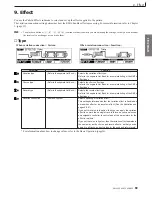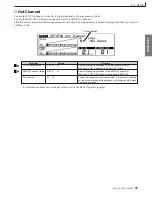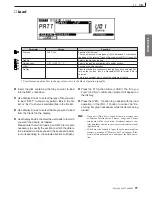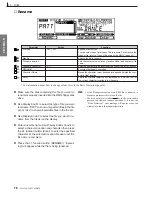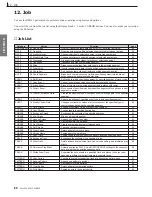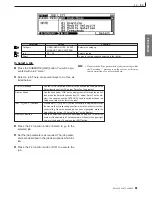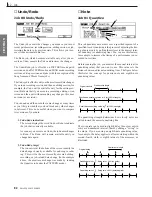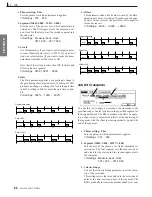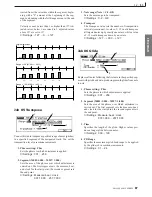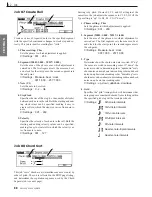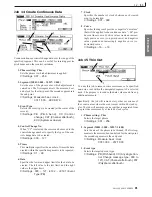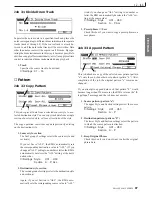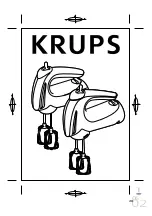
82
RM1x SEQUENCE REMIXER
PA
TTERN MODE
12. Job
❏
Undo/Redo
Job 00 Undo/Redo
1
2
The Undo job cancels the changes you made in your most
recent patch session, recording session, editing session, or job,
restoring the data to its previous state. This allows you to re-
cover from accidental data loss.
The Redo job, which becomes available only after you ex-
ecute an Undo, cancels the Undo and restores the changes.
The Undo/Redo job is effective on PATTERN mode patch
sessions, and on PATTERN mode and SONG mode recording
sessions, editing sessions, and jobs (with the exception of the
Song Name and Phrase Name jobs).
The Undo job is effective only on the most recent data changes.
If you run a recording session and then an editing session, for
example, the Undo will be available only for the editing ses-
sion. (But note that if you move to a recording, editing, or job
screen and then quit without making any changes, this does
not count as a session.)
You can undo and then redo the same change as many times
as you like (provided that you don’t make any other changes
in between). This can be useful when you want to compare
two versions of your data.
1. Undo/Redo indication
The screen displays the word Undo or Redo to indicate
the job that is currently available.
As soon as you execute an Undo, the job name changes
to Redo. The Redo will remain available until you
change data again.
2. Undo/Redo target
The two entries at the bottom of the screen identify the
data-change currently available for undoing or redo-
ing. This will be the most recently executed editing,
recording, or job-related data change. (In the example
above, the most recent change was made by running
the Quantize job under the PATTERN mode.)
❏
Note
Job 01 Quantize
1
3
2
4
5
6
This job quantizes note events over a specified segment of a
specified track. Quantizing is the process of adjusting the tim-
ing of note events by pulling them closer to the nearest inter-
val boundary (or quantizing line). You can use this feature,
for example, to improve the timing of a performance you re-
corded in real time.
Before running the job, you must set the musical interval (or
quantizing value) that you want to use. This value sets the
distance between adjacent quantizing lines. The figure below
illustrates the concept for quarter-note and eighth-note
quantizing values.
Original note data
Quarter-note length
Result when quantizing value is (at 100% strength)
Result when quantizing value is (at 100% strength)
The quantizing strength determines how closely notes are
pulled toward the nearest quantizing line.
The swing rate can be used to slightly delay the note events in
every even-numbered interval, thereby adding a “swing” to
the music. If you are using an eighth-note quantizing value,
for example, the delay applies to all notes starting within the
second, fourth, sixth, or eighth interval of the measures, as
illustrated.
Original timing
Quantizing value = , Swing rate = 50% (no delay)
Quantizing value = , Swing rate = 60% (delay applied)
Quarter-note length


